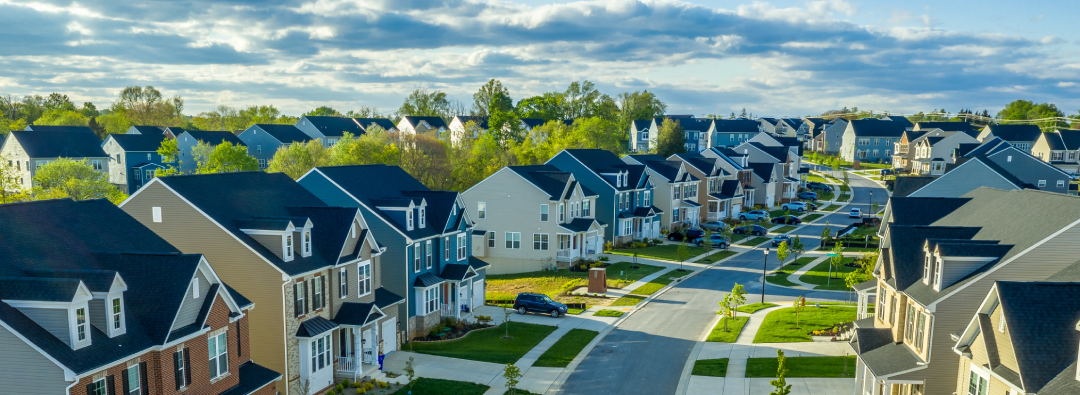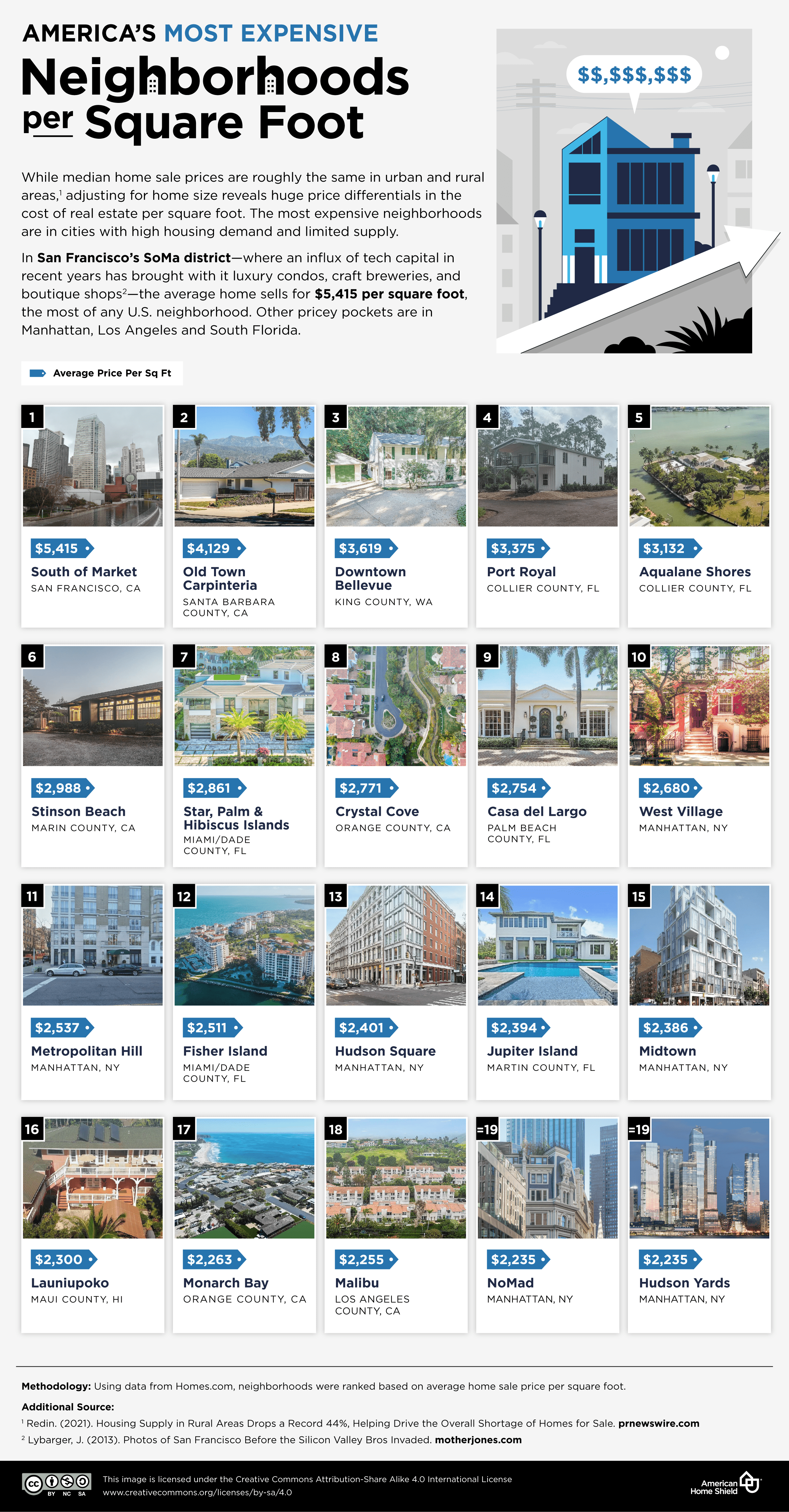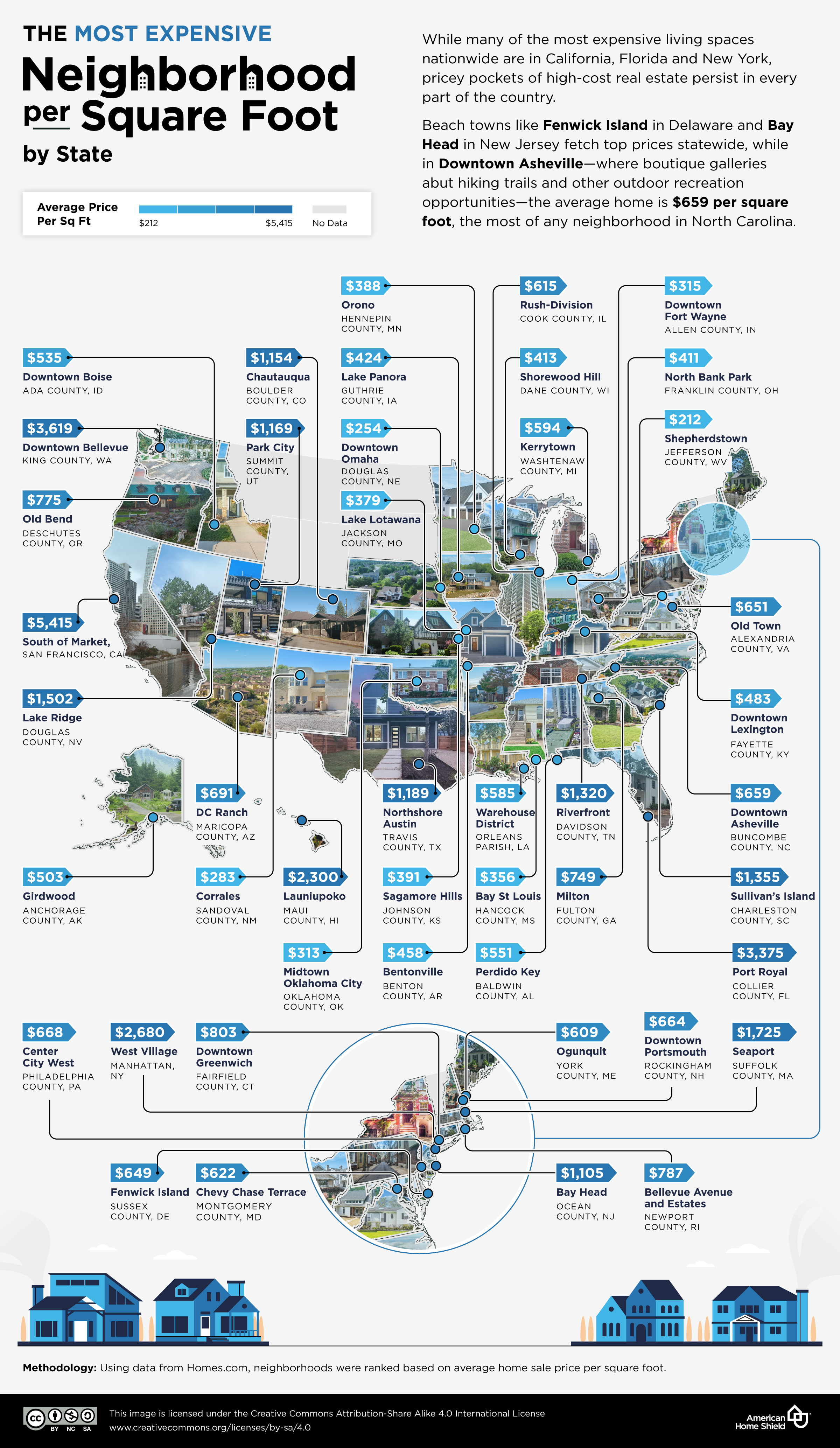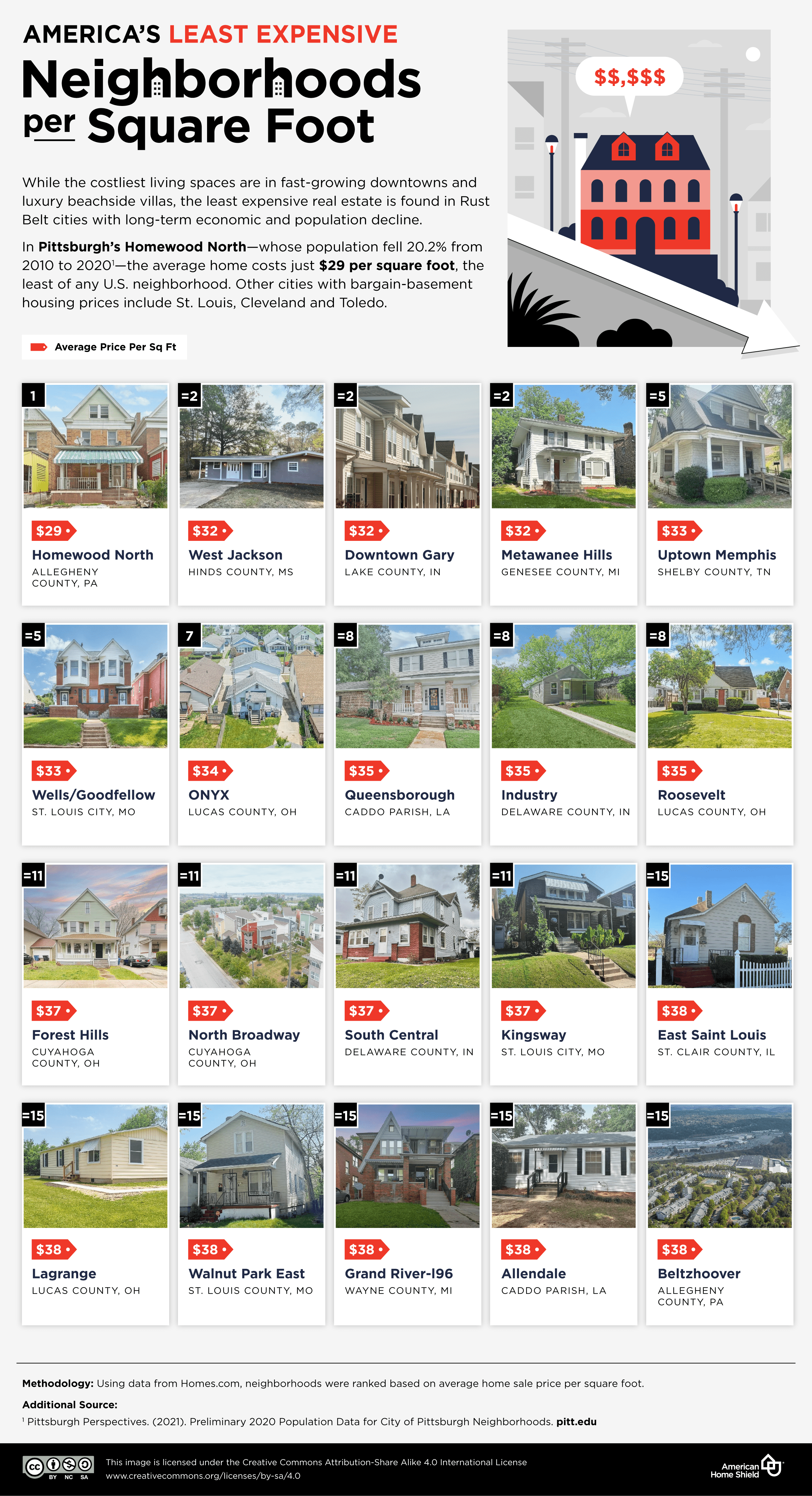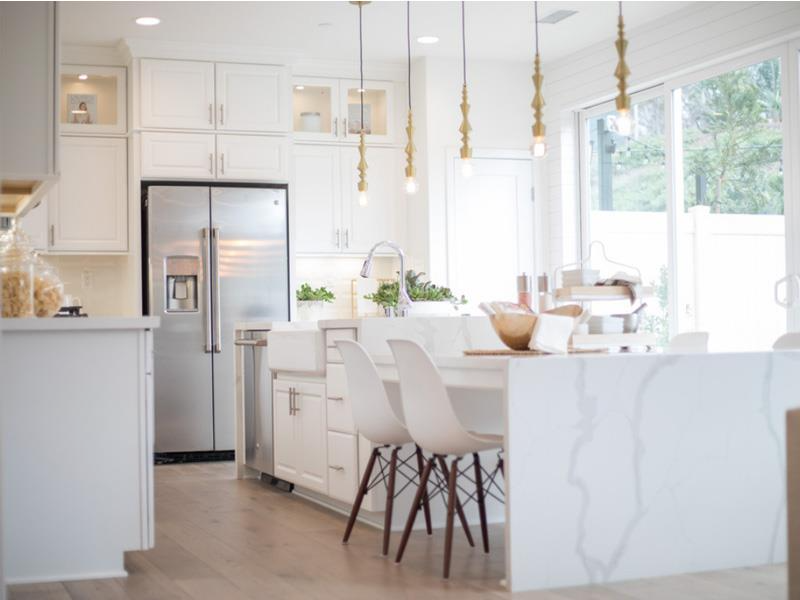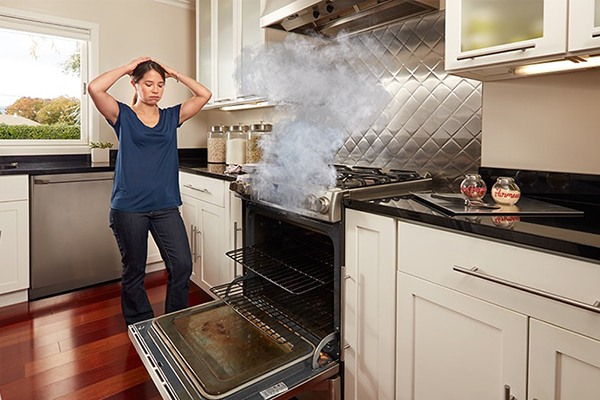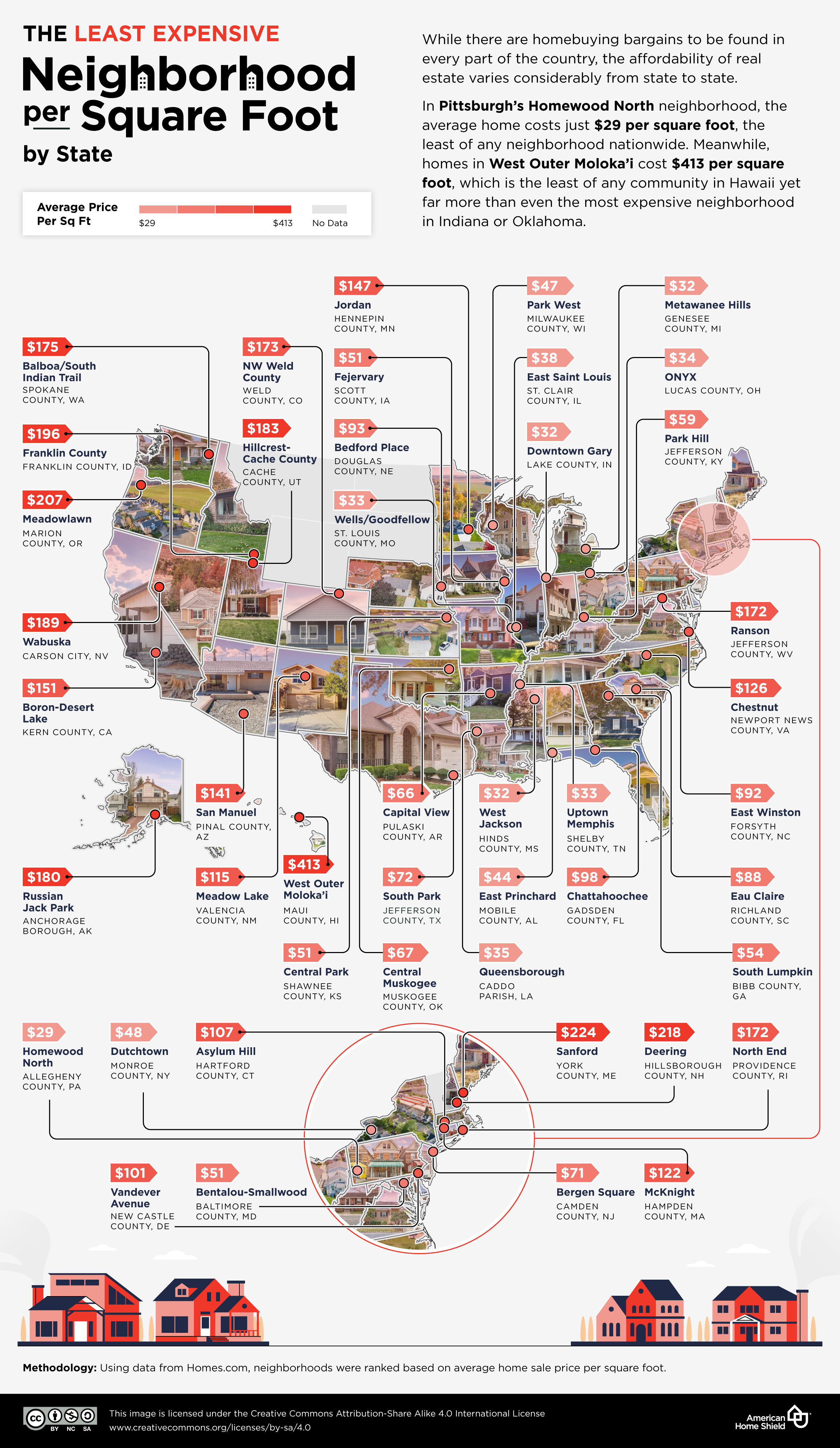
Our map above uncovers each state’s least expensive neighborhood per square foot. In Mississippi — the state with the lowest cost of living — West Jackson in Hinds County takes the title ($32). Meanwhile, in Hawaii — the most expensive state in which to live — the least expensive neighborhood to buy a home in (West Outer Molokai) is still pricey at $413 per square foot.
At $2,680 per Square Foot, the West Village Is NYC’s Most Expensive Neighborhood
Like San Francisco, New York City is one of the most expensive places in the world to live. Most locals rent where they live, but renting even the smallest apartments in the city can cost over a thousand dollars a month. When it comes to buying, no other neighborhood is as expensive as the trendy West Village, where the average property sells for $2,680 per square foot. This historically bohemian neighborhood is now a favorite among Big Apple-based celebrities.
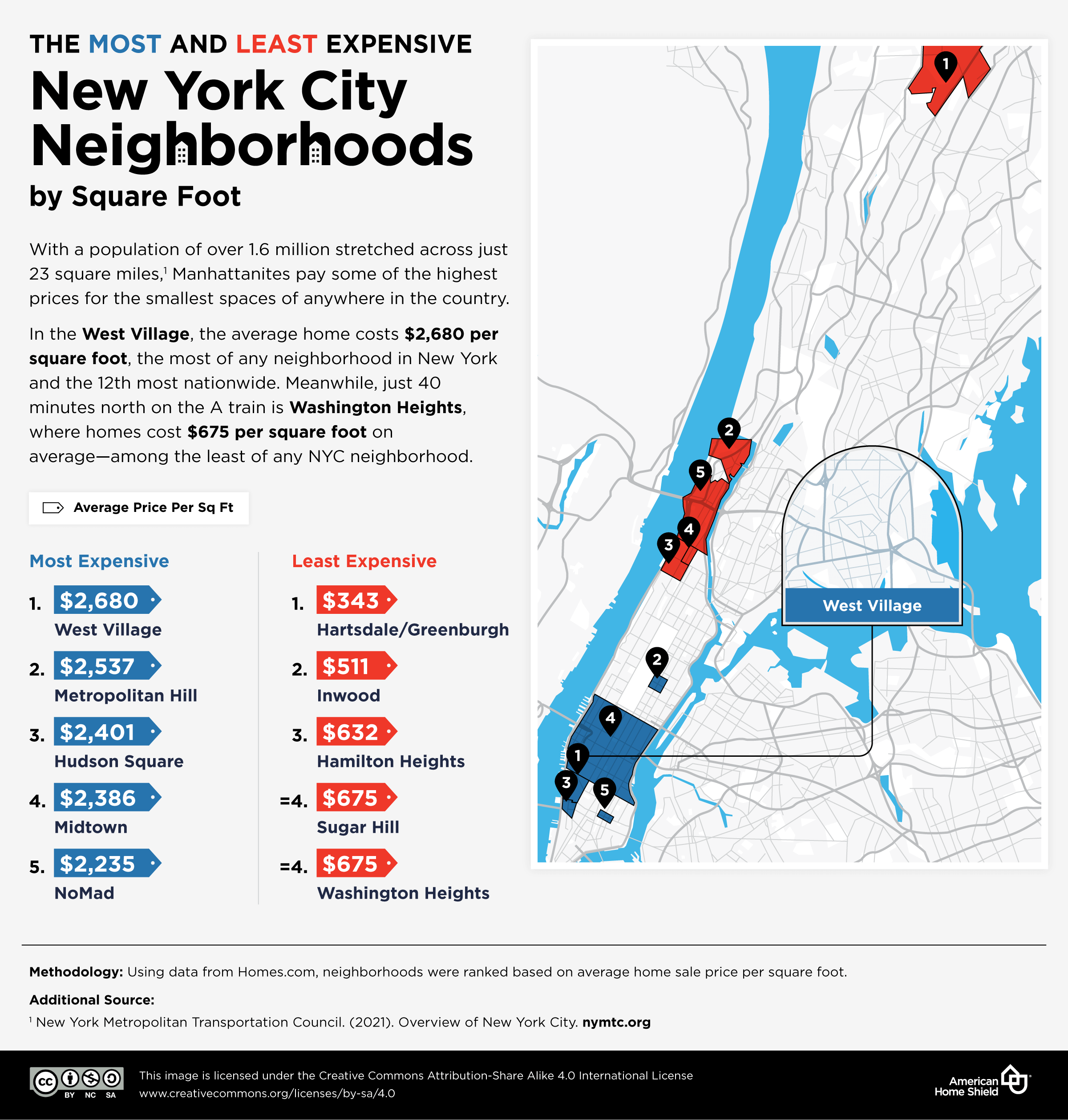
Those with less cash to splash have a better chance of buying in Hartsdale, where the average property costs just $343 per square foot — the least expensive rate in the city. This hamlet in the town of Greenburgh is just over 20 miles north of Manhattan. Here, the New York Times writes that “housing stock runs the gamut from one-bedroom apartments to five-bedroom homes on large plots.”
Bel Air Is Los Angeles’ Most Expensive Neighborhood for Homes
Los Angeles is synonymous with the rich and famous — but which of its many neighborhoods is the most expensive to buy a property in? Bel Air comes top in that respect, an exclusive gated community where the average square foot of property will set you back $1,318. To give you an idea of just how expensive properties here can get, the local Casa Encantada home is on sale (as of December 2023) for a staggering $195 million. At roughly 40,000 square feet, that translates to $4,875 per square foot.
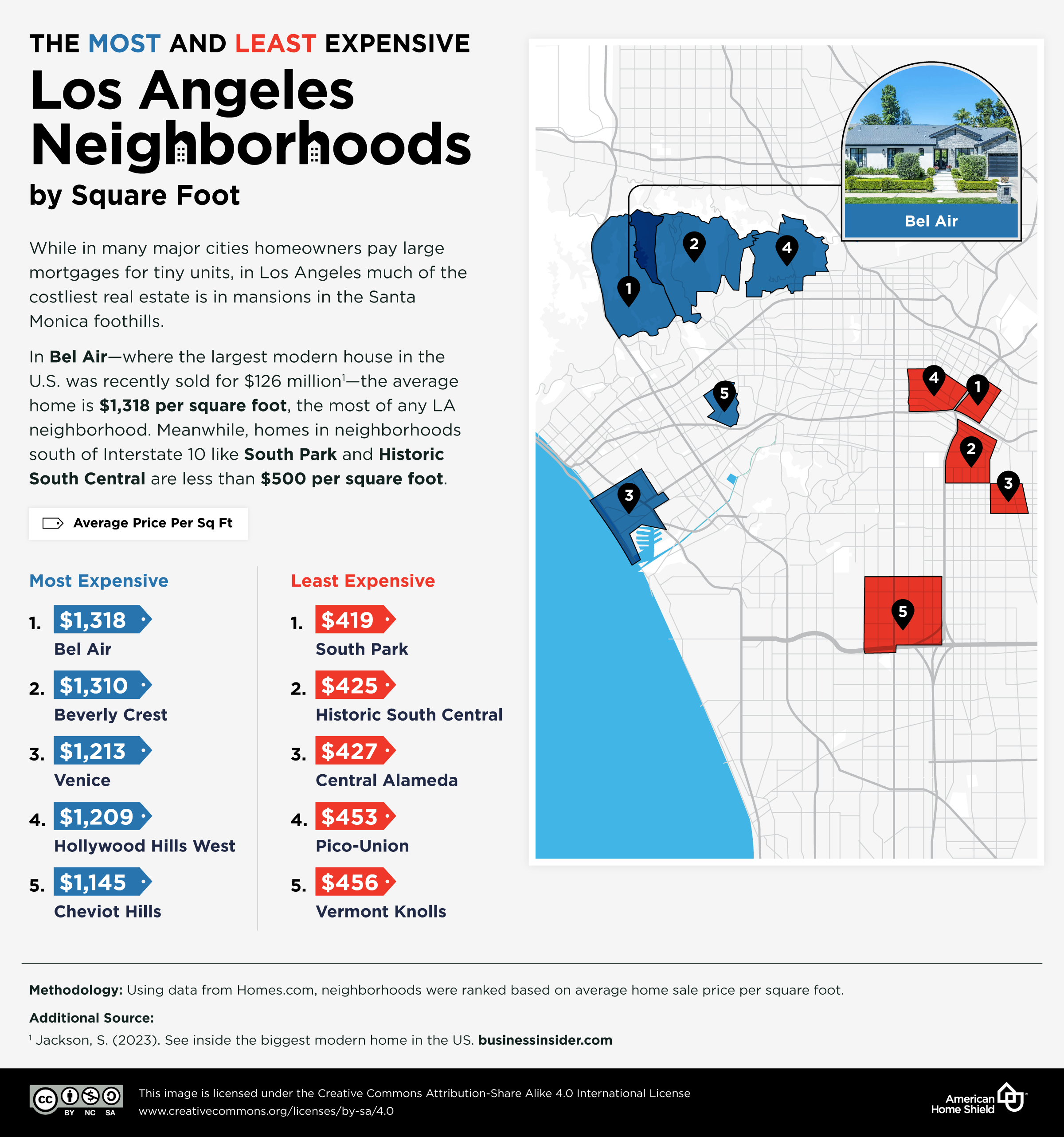
Around half an hour’s drive from Bel Air is the neighborhood of South Park, placed as the least expensive neighborhood in Los Angeles, where the average square foot of property costs $419. Situated in the sprawling city’s Downtown, the downsides of living in this neighborhood include noise pollution from the traffic and nightlife and a crime rate 492% above the national average.
Magnificent Mile Among Chicago’s Priciest Neighborhoods per Square Foot
Chicago’s Rush & Division ranks as the city’s most expensive neighborhood in which to buy a home, with the average property priced at $615 per square foot. Situated in the Windy City’s historic Gold Coast district (one of the most affluent neighborhoods in the U.S.), the average household income in this neighborhood is a very comfortable $125k. The famous Magnificent Mile also ranks highly ($507 per square foot), home to luxury stores, high-end restaurants and iconic landmarks.

In contrast, the lakefront community of South Shore ranks as the least expensive Chicago neighborhood — properties here cost a mere $98 per square foot. According to the South Shore Housing Data Project: “... The community … has a higher poverty rate (30%) than the city of Chicago (17%) and continues to house the highest number of households renting with [Housing Choice Voucher] subsidies in the city.”
In Philadelphia, Center City West Is the Most Expensive Neighborhood for Property
In Philadelphia, the Center City West neighborhood ranks as the most expensive in the city in which to buy a home, with the average square foot of property costing $668. This area — packed with upscale shops, restaurants and museums — is situated just a stone’s throw from Fitler Square and Rittenhouse Square, two neighborhoods placed among the city’s most affluent and second ($623) and third ($526) in our ranking below.
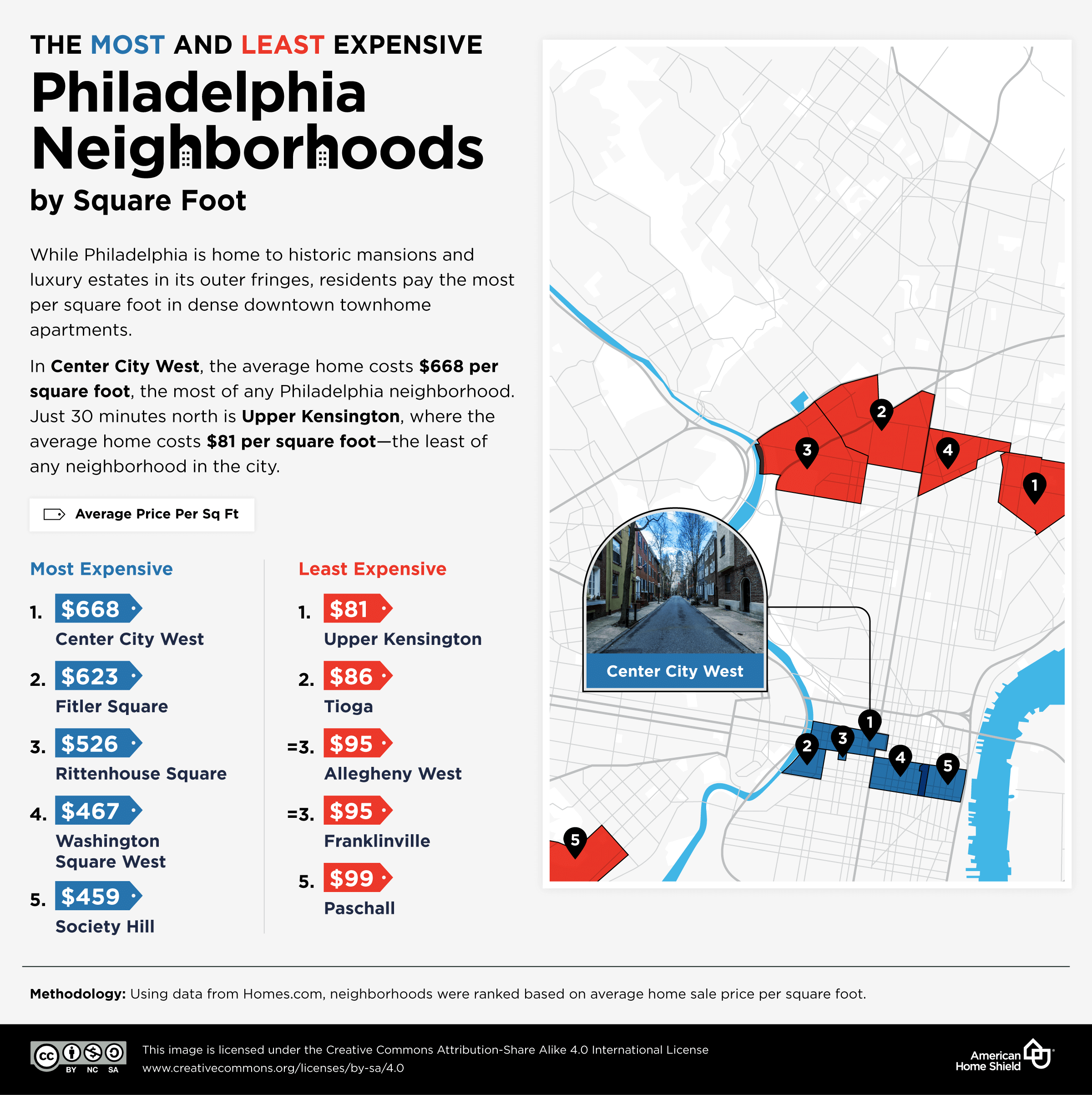
But elsewhere in the City of Brotherly Love, the cost of property is a lot less expensive. Upper Kensington comes top in that respect ($81 per square foot), followed by Tioga ($86 per square foot), a neighborhood where development has “languished” compared to other areas of the city and the poverty rate has hovered around 35% for the last ten years.
Homes in River Oaks Cost $481 per Square Foot (More Than Anywhere Else in Houston)
Houston is home to one of the highest populations of millionaires of any U.S. city. Just as well, then, that some neighborhoods have the property prices to match. On top is River Oaks, a community in the center of the city, where the average home sells for $481 per square foot. This affluent neighborhood was planned and founded in the 1920s by two brothers, eventually becoming a national model for planned communities that attracted wealthier residents over time.
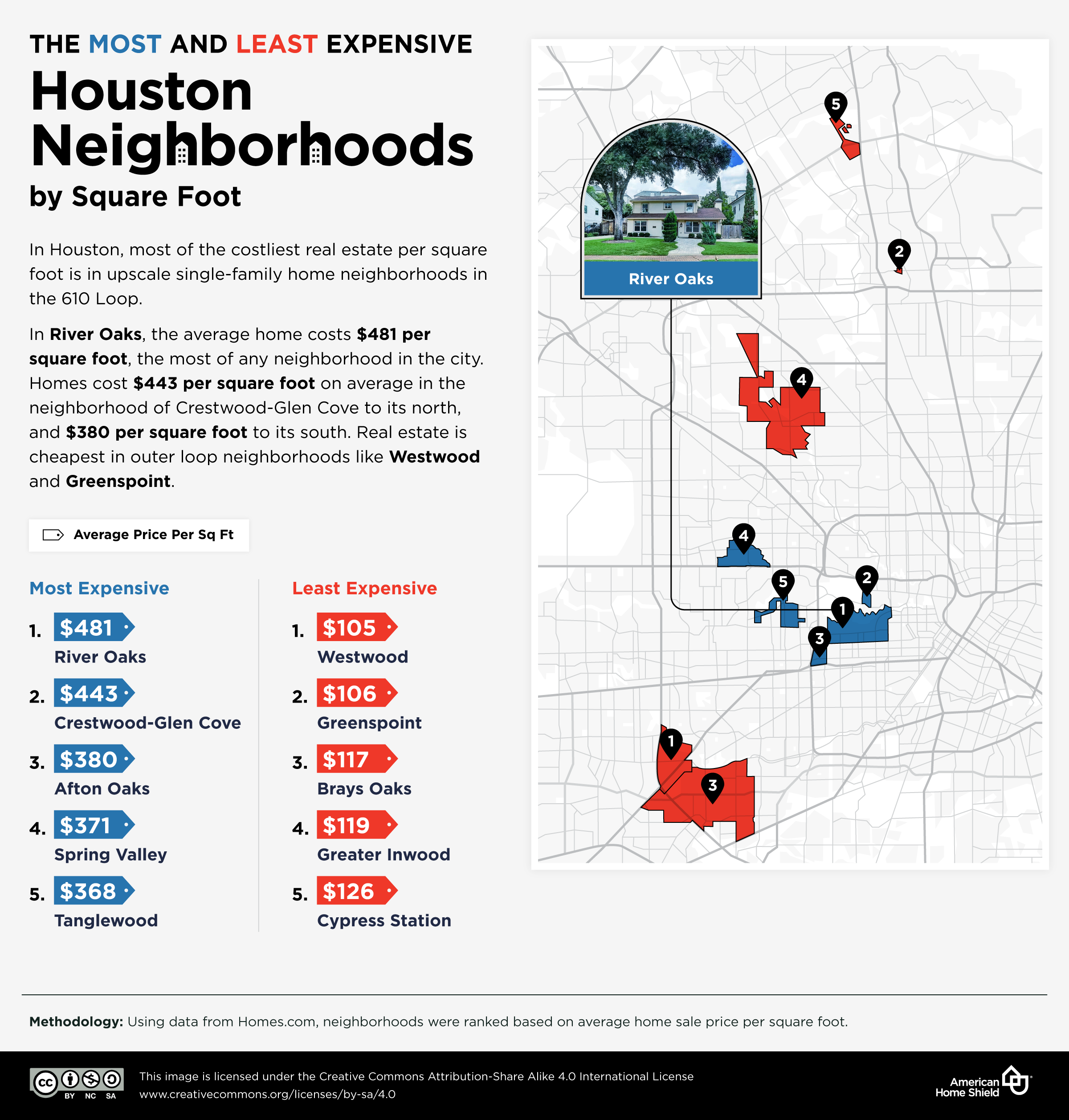
Meanwhile, Westwood ranks as the other end of the scale — here, the average property will set you back $105 per square foot. Greenspoint comes next ($106 per square foot), the fourth-most dangerous neighborhood in Houston in terms of the local crime rate and home to a large low-income population.
How to Choose the Right Location When Buying a House
They say when it comes to finding the right house, it’s all about “location, location, location…” But where are you supposed to start? Take a look at our tips below on finding the right location for your next home.
1. Plan around your budget
The very first step in your search for a new home is to take a look at your budget. If you can’t afford the likes of LA’s glitzy Bel Air community or the West Village in New York, it goes without saying that there’s just no point in looking at houses for sale there! Once you have an idea of the rough location you want to move to, research local house prices to settle on a neighborhood that fits your budget.
2. Map out your commute
Next, think about your work. If you need to commute to the office, consider what the commute would be like from your potential future neighborhood. Will you need to drive or make use of public transportation? What is the local public transportation like? How expensive might your travel costs be? Consider how long it will take, too. You don’t want to sign up for a long and miserable daily commute.
3. Think about nearby amenities
Living in the middle of nowhere isn’t everyone’s idea of a dream home! When searching for a new neighborhood, check out the local amenities. Prioritize the things that are important to you, whether that’s a mall, a children’s park or easy access to a highway.
4. Check out local schools
Speaking of amenities, those with kids (or planning for them in the future) should think about local schools. If you plan on driving your kids to school, think about the distance from your house and how long it will take you to do the drop-off and pick-up every day. If your kids will walk to school — offering the opportunity for plenty of fresh air and exercise — you might prefer to live closer to a school so your children can navigate safe, walkable routes.
5. Research crime rates
Nobody wants to think about crime, but local crime rates are an important factor in choosing where to live. Websites like AreaVibes can offer statistics on neighborhood crime rates broken down into the type of crime committed and how it compares to other areas.
When it’s time to visit a house, consider dedicating the day or even the weekend to exploring the local area. The more time you spend doing in-depth research about the neighborhood, the easier it will be to come to a decision when it’s time to make an offer.
Methodology
To determine the most and least expensive American neighborhoods per square foot, we reviewed data on listing prices and home size in over 20,000 neighborhoods from Homes.com. Neighborhoods were ranked based on the average sale price per square foot as of December 2023. Neighborhoods with fewer than 10 sales in the previous 12 months were excluded. Five states with no neighborhood data — Montana, South Dakota, Wyoming, North Dakota and Virginia — were not considered.
Additional Sources
- Redin. (2021). Housing Supply in Rural Areas Drops a Record 44%, Helping Drive the Overall Shortage of Homes for Sale. prnewswire.com
- Lybarger, J. (2013). Photos of San Francisco Before the Silicon Valley Bros Invaded. motherjones.com
- Pittsburgh Perspectives. (2021). Preliminary 2020 Population Data for City of Pittsburgh Neighborhoods. pitt.edu
- New York Metropolitan Transportation Council. (2021). Overview of New York City. nymtc.org
- Jackson, S. (2023). See inside the biggest modern home in the US, a 105,000-square-foot Los Angeles megamansion that sold for $126 million to Fashion Nova's billionaire CEO. businessinsider.com
